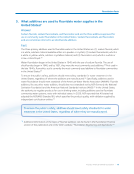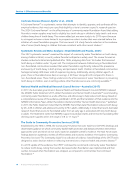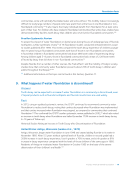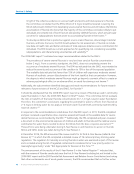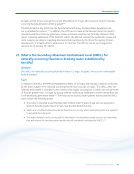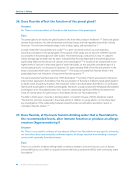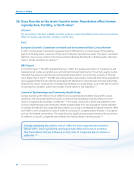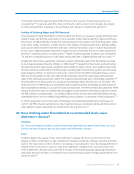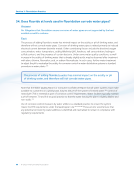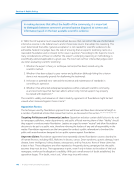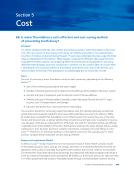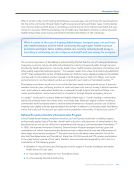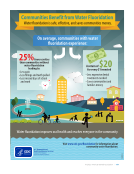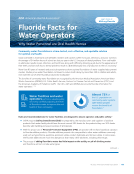© 2025 American Dental Association l 99
Fluoridation Facts
Consequently, the court ordered the EPA to engage in regulatory actions under the TSCA to mitigate
these risks. However, the ruling does not prescribe a specific regulatory outcome, leaving the EPA to
determine the appropriate response while acknowledging that the risk identified must be addressed.
The District Court’s ruling has been criticized widely by major health and scientific authorities for
drawing conclusions that are not supported by the best available evidence. For example, the AAP noted
that the court drew heavily on the NTP review in its opinion, despite explicit declarations by the NTP
that its document did not evaluate a potential risk of harm from drinking water with fluoride at the
optimal US level of 0.7 mg/L.441 Similarly, the American Association for Dental, Oral, and Craniofacial
Research noted that the court’s decision exceeded what NTP concluded in its systematic review of the
evidence.442 At the time of this document preparation, the EPA has appealed the court’s ruling.
62. Why does opposition to community water fluoridation continue?
Answer
Controversies sometimes exist regarding public health interventions. In public health, there can
be tension between “public good” and “individual freedoms.” Because public health deals with
populations, it is all but impossible to resolve issues to achieve approval from 100% of the individuals
within the population. When looking at fluoridation, some individuals opposed to fluoridation are
sincere in their beliefs. Others ignore what constitutes reputable scientific evidence as defined by
the vast majority of the scientific community and choose instead to base their beliefs on personal
opinions and studies with flawed methodologies. Community water fluoridation is only one such
public health issue that is considered controversial despite overwhelming scientific evidence.
Fact
Community water fluoridation is considered beneficial by the overwhelming majority of the health
and scientific communities, as well as the general public.39,42,416 A vast body of scientific literature
endorses water fluoridation as a safe means of reducing the incidence of tooth decay. Support for
fluoridation among scientists and health professionals, including physicians and dentists, is nearly
universal. Recognition of the benefits of fluoridation by the ADA,3 the AMA,5 the AAP,6 the WHO,431
governmental agencies,39 and other national health and civic organizations417,420 continues as a result
of published, peer-reviewed research.
Fluoridation has a long history of being a political issue, as well as a scientific one, with opposition
including activists from both the right and the left of the political spectrum. In the late 1940s,
opposition to fluoridation began to appear around the nation. Reportedly, one of the first public
votes on fluoridation occurred in 1950 in Stevens Point, Wisconsin,443 when a local activist
initiated a campaign to stop the introduction of what he called “poison” into the water system.
The campaign quickly moved from being a discussion of the science to a political campaign that
included the involvement of a large number of civic groups, unofficial public petitions, calls for a
debate, campaign rallies, and numerous letters to the editor that “kept typesetters busy preparing
for print the thousands of words that poured into the editor’s desk.”443 After 1950 when the PHS
and the ADA endorsed fluoridation, proponents became more organized in their efforts to promote
fluoridation, while the opposition capitalized on the political nature of the struggle and used lessons
learned in Stevens Point.
Fluoridation Facts
Consequently, the court ordered the EPA to engage in regulatory actions under the TSCA to mitigate
these risks. However, the ruling does not prescribe a specific regulatory outcome, leaving the EPA to
determine the appropriate response while acknowledging that the risk identified must be addressed.
The District Court’s ruling has been criticized widely by major health and scientific authorities for
drawing conclusions that are not supported by the best available evidence. For example, the AAP noted
that the court drew heavily on the NTP review in its opinion, despite explicit declarations by the NTP
that its document did not evaluate a potential risk of harm from drinking water with fluoride at the
optimal US level of 0.7 mg/L.441 Similarly, the American Association for Dental, Oral, and Craniofacial
Research noted that the court’s decision exceeded what NTP concluded in its systematic review of the
evidence.442 At the time of this document preparation, the EPA has appealed the court’s ruling.
62. Why does opposition to community water fluoridation continue?
Answer
Controversies sometimes exist regarding public health interventions. In public health, there can
be tension between “public good” and “individual freedoms.” Because public health deals with
populations, it is all but impossible to resolve issues to achieve approval from 100% of the individuals
within the population. When looking at fluoridation, some individuals opposed to fluoridation are
sincere in their beliefs. Others ignore what constitutes reputable scientific evidence as defined by
the vast majority of the scientific community and choose instead to base their beliefs on personal
opinions and studies with flawed methodologies. Community water fluoridation is only one such
public health issue that is considered controversial despite overwhelming scientific evidence.
Fact
Community water fluoridation is considered beneficial by the overwhelming majority of the health
and scientific communities, as well as the general public.39,42,416 A vast body of scientific literature
endorses water fluoridation as a safe means of reducing the incidence of tooth decay. Support for
fluoridation among scientists and health professionals, including physicians and dentists, is nearly
universal. Recognition of the benefits of fluoridation by the ADA,3 the AMA,5 the AAP,6 the WHO,431
governmental agencies,39 and other national health and civic organizations417,420 continues as a result
of published, peer-reviewed research.
Fluoridation has a long history of being a political issue, as well as a scientific one, with opposition
including activists from both the right and the left of the political spectrum. In the late 1940s,
opposition to fluoridation began to appear around the nation. Reportedly, one of the first public
votes on fluoridation occurred in 1950 in Stevens Point, Wisconsin,443 when a local activist
initiated a campaign to stop the introduction of what he called “poison” into the water system.
The campaign quickly moved from being a discussion of the science to a political campaign that
included the involvement of a large number of civic groups, unofficial public petitions, calls for a
debate, campaign rallies, and numerous letters to the editor that “kept typesetters busy preparing
for print the thousands of words that poured into the editor’s desk.”443 After 1950 when the PHS
and the ADA endorsed fluoridation, proponents became more organized in their efforts to promote
fluoridation, while the opposition capitalized on the political nature of the struggle and used lessons
learned in Stevens Point.























